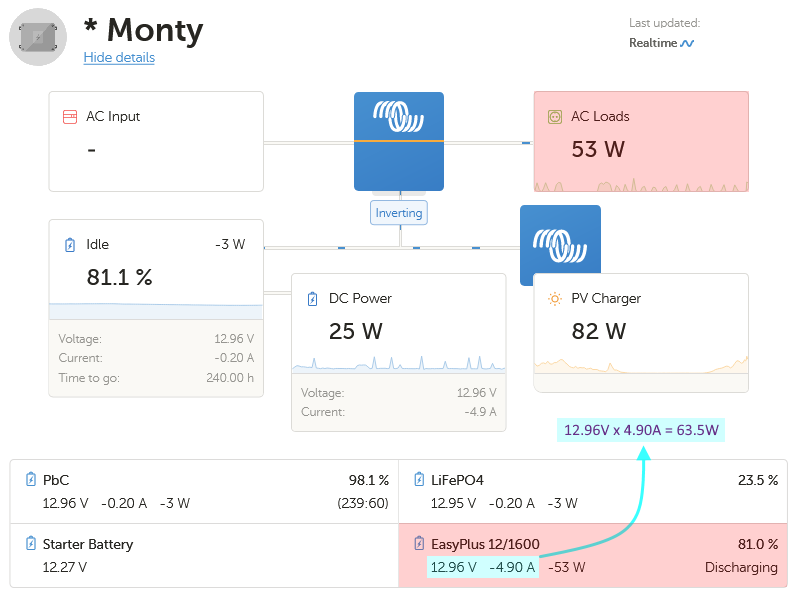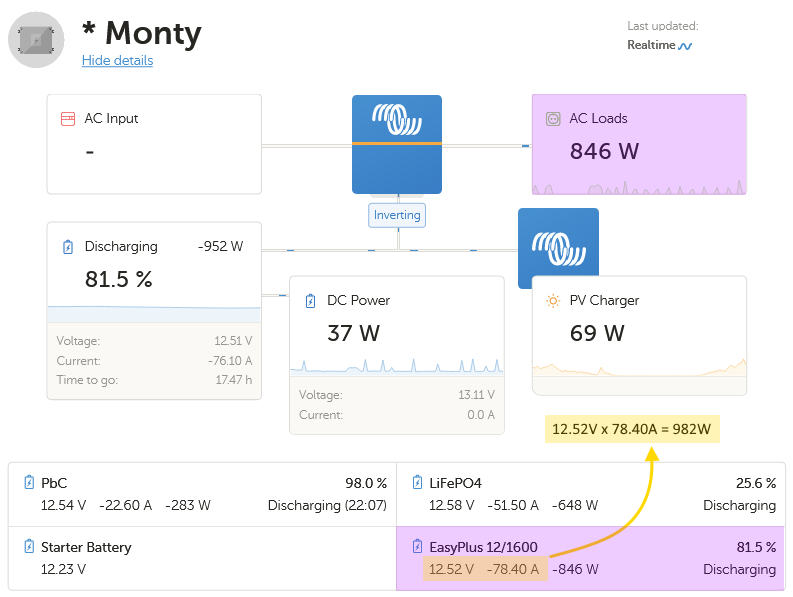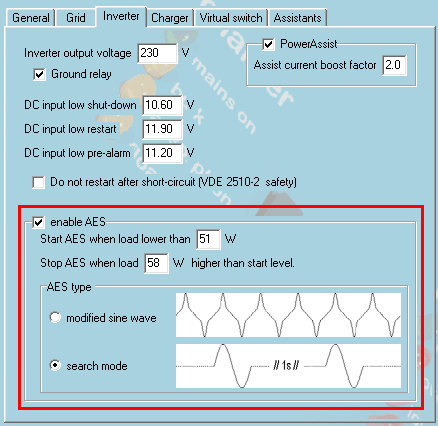Introduction
All Inverters have overheads of course, and it is useful to know what that overhead is to convert what the Wattage quoted on the label of an AC device you have actually translates to when used off your Batteries via an inverter.
This might be of particular interest to Victron MultiPlus users, especially if they also use a Venus OS unit such as a CCGX, Venus GX, Cerbo GX, etc or even a Raspberry Pi or Beaglebone, as I am using an EasyPlus 12/1600 for the data shown and a Victron Datasheet.
So let’s start by looking at the Datasheet for the Multipluses – But first a bit of an introduction to the product ….
The Victron Multiplus is a combined Inverter & Charger with some extra features on top – check out the link here from Victron, and an idea of costs of the devices here and here. The EasyPlus I am using is basically the Multiplus with integrated AC Consumer Unit, and the EasySolar is an EasyPlus with a 100/50 MPPT Solar Controller within the housing for a very neat all-in-one installation.
Ok, the Datasheet …
The first thing that should probably note for anyone not familiar with the way Victron name their products … The output of the Multipluses (and Inverters) are in VA (Volt-Amperes) and not in Watts. VAs are technically more accurate and appropriate for transformers and therefore Inverters, and Victron being a very engineering led company therefore use the VA rating. But they do provide what is a typical Wattage conversion to the VA which is handy. (The VA vs Watts is a separate, but interesting, discussion so we will park that bit for another time).

The sheet above shows the Wattage output below the VA Output. You can see that for example the 12/3000/120 has a 3000VA output but it is 2400W. The EasyPlus I am using for this post is the 12/1600/70, which is a 1300W inverter (p.s. the last number is the charger output – so the “70” in 12/1600/70 means it has a 70A battery charger). So if you have a non-Victron inverter, you can maybe relate yours to the appropriate Victron unit for a comparison – e.g. if you have/want a 1000W Inverter, the Multiplus 12/1200 would be the equivalent.
I have highlighted two areas on the table which are of key interest for this discussion.
- Maximum efficiency (%). This tells you how much power the Inverter needs to draw from the batteries in order to deliver the output power. This efficiency is the maximum possible and is usually actually a fair bit less efficient in actual use (and it does depend on the type of load also really)
- Zero Load Power (W). Now this is an indication of how much power is drawn when the inverter is on, but nothing is plugged into it. Depending on the Inverter you have there will be various different ways to use it. You can just switch it off when you don’t need it (no power wasted at all that way!); You can just leave it on all the time (most power wasted that way!); Or you can use on many inverters some kind of energy saving mode where the inverter is in a standby mode and ‘wakes up’ automatically when needed. How well this works for depends on the type of devices you use – it can be great for some, and not be good for others. We will revist this later.
Inverter Efficiency
Looking at the inverter efficiency first, that is the key question really. How much energy is sucked out the battery when you use the inverter? To test this, I have ran 3 different AC devices in my Motorhome to illustrate. These are all devices that are installed permenantly and I use on a regular basis, so is a ‘real world’ test.
230V AC Fridge/Freezer.
I have a 230V Compressor Fridge/Freezer installed in my Motorhome rather than the more conventional 3-Way Fridge or 12V Compressor Fridges. The reason for this is quite simple – cost! A 230V Fridge is typically 1/5th the price of a 12V Fridge to buy; if chosen well is just as efficient; and if you already have a decent inverter installed, make great sense (see my Blog Post A Home Fridge in a Campervan?? originally published in 2018)
The screenshot below from Victrons VRM platform showing the Dashboard of my Motorhome (“Monty”) while the fridge is running. I have highlighted in Pink the key information points.

The “AC Loads” shown is the power the Fridge is pulling from the Inverter. In this case, 53W. That is very efficient for a Fridge/Freezer considering it is only actually actively running around 25% of the time – so the average power draw would be about 13W/Hr (this will vary depending on ambient temperatures, how often the doors are opened, etc). But how much is getting drawn from the battery though?
The info in the blue boxes tells us this – the device pulls 53W, but the inverter is drawing 4.90A from the Battery system. At a Battery Voltage of 12.96V, that comes to 63.5W. So the actual power use we care about in an off-grid situation is 63.5W. It is still only 1/4 of the time though, so 16W/Hr, or 1.22Ah/Hr at that voltage shown.
But what about the 75% of the time the fridge is not running? how much power is being wasted with the inverter having to be ready to supply the fridge? Hold that thought – we will come back to that when we look at the Zero Load Power side of using an inverter. Let’s look at some other devices first and see what they use? (this is like an episode of “Real Power of Household Devices”! I think that is a spin-off of Real Housewives?)
Truma Ultrastore
The Truma Ultrastore is a 10L Water Boiler, typically fitted with a gas burner and an AC Element of 850W. I use the electric side of the Ultrastore to utlise Solar Power that would otherwise go to waste (when more power can be harvested than the system can make use of such as when the battery bank is full for example)
Similar to the previous screenshot, this is the Dashboard when the Ultrastore is running off the Inverter. Information highlighted, this time in a nice shade of lilac.

The “AC Loads” this time are just for the Boiler and show 846W being drawn. When we look at the info from the bottom right box for the EasyPlus, we see it is taking 78.40A from the Battery system, this time at a lower voltage of 12.52V (even though the battery has a slightly higher SOC (State of Charge), the fairly high load is causing a voltage drop (perfectly normal and the reason why it is important to use appropriately sized battery connection cables to help reduce the impact).
That voltage and current combination end up meaning that the 846W the boiler is using ends up being 982W from the battery – a fair difference there.
800W Microwave
Our final device is a Microwave. It is an 800W Microwave, so actually has an input power of between 1200-1300W (the “800W” is ‘cooking power’).
This is what it looks like on the Dashboard, in a fetching green tone

It has a draw of 1243W, but the actual power out the Battery system is 1585W (over 300W more) with the inverter overhead. As was seen with the boiler, the higher load results in DC Voltage Drop and so the current goes up to be able to provide the required power into the Inverter
Efficiency Calculations
How do the results compare to the quoted max efficiency? not very well, but then I didn’t really expect them to, to be honest. Doing the maths …
- Fridge: Power Watts OUT of Inverter = 53W; Power Watts IN to Inverter = 63.5W. Overhead Loses = 10.5W, Efficiency ~ 85%
- Boiler: Power Watts OUT of Inverter = 846W; Power Watts IN to Inverter = 982W. Overhead Loses = 136W, Efficiency ~ 85%
- Microwave: Power Watts OUT of Inverter = 1243W; Power Watts IN to Inverter = 1585W. Overhead Loses = 342W, Efficiency ~ 78%
I would have expected the efficiency to have increased as the load gets closer to the inverter power limits but it didn’t in this case. Maybe due to the type of load the microwave presented?
Zero Load Power
The Zero Load Power use is useful to know as well. According to the Victron Datasheet posted at the top, the MultiPlus 12/1600 Zero Load is either 8W, 5W or 2W, depending on how you set it up.
- 8W is the Zero Load overhead if you don’t enable any energy saving
- 5W is the Zero Load overhead if you enable AES Mode (here they mean AES Modified Sine Wave Mode, where the sine wave is changed to reduce voltage when not required)
- 2W is the Zero Load overhead for Search Mode (to be accurate, this is AES Search Mode)
Different inverters will have different modes and results. AES is a MultiPlus mode, the Victron Phoenix inverters have an “ECO” mode, other brands will do their own thing.
If you use the Inverter at specific times for specific purposes, then a manual on/off could do the job – say to turn it on when you want to use the Microwave – but for something like a Fridge that comes on and off by itself, you either have to leave it on or use a power-saving mode if possible.
The following shows the configuration for my Multiplus 12/1600

I have enabled Search Mode within the AES options. So every second the Inverter checks to see if there is a load higher than the specified value (58W in my case) is detected. This means that the Inverter is essentially in a standby (or “Low Power”) mode until it is called on.
And this is what it looks like at the VRM Dashboard

Whilst there is no AC Load, the Inverter (centre-top Blue Box) is in “Low power” mode and there is a 2W draw on the Battery system. If I had the other AES mode running, it would say 5W, and if just on (so “Inverting”) it would be drawing 8W. 8W does not sound a great deal but it is 6W more than 2W – or a nominal 0.5A at 12V – which adds upto 12Ah a day potentially of wasted energy which could be saved by some configuration pre-thought.
Conclusions
Well, there are no real conclusions. This was just a post that I thought might be interesting and to provide some thought to using Inverters and if they are the wasteful power hogs that are claimed, backed up with some real data.
Yes, If you had two devices drawing xxx Watts, the 12V DC version would use less power out the Battery System than the 230V AC one – but I would ask at what cost? as mentioned, a 230V fridge is substantially cheaper than a 12V fridge, and at that saving, I am more than happy to waste around 4W or so an hour on the Inverter Overhead.
Other devices I have such as an Amazon Echo are supplied with AC transformers and they use so little power running an inverter for that purpose would be incredibly inefficient so for that kind of device I converted it to run off 12V directly.
It is possible to buy 12V versions of other 230V AC Devices, such as Laptop chargers for example. It becomes a choice between being cost-efficient and energy-efficient and balancing the price of buying additional chargers against the cost of using the extra power (and how much you use the chargers becomes a factor also).
To some, the numbers will say “ditch the inverter”, and to others they say “use the inverter”. Too many variables to make a definate conclusion here, but for myself, I will continue to use the Inverter feature of the EasyPlus as I find it convenient and useful 🙂
